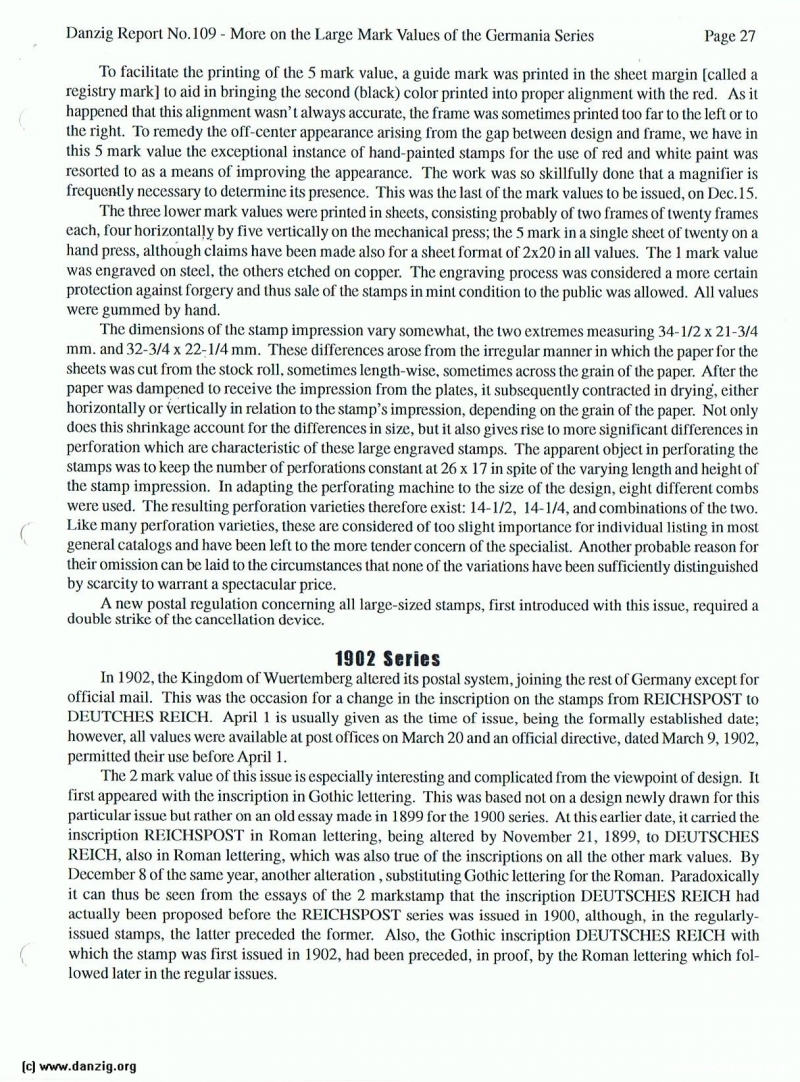
To facilitate the printing of the 5 mark value, a guide mark was printed in the sheet margin [called a registry mark] to aid in bringing (lie second (black) color printed into proper alignment with the red. As it happened that this alignment wasn’t always accurate, the frame was sometimes printed too far to the left or to the right. To remedy the off-center appearance arising from the gap between design and frame, we have in this 5 mark value the exceptional instance of hand-painted stamps br the usc of red and white paint was resorted to as a means of improving the appearance. The work was so skillfully (lone that a magnifier is frequently necessary to determine its presence. This was the last of the mark values to be issued, on Dec.15.
The three lower mark values were printed in sheets, consisting probably of two frames of twenty frames each, four horizontally by five vertically on thc mechanical press; the 5 mark in a single sheet of twenty on a hand press, although claims have been made also for a sheet format of 2x20 in all values. The I mark value was engraved on steel, the others etched on copper. The engraving process was considered a more certain protection against forgery arid thus sale of the stamps in mint condition to the public was allowed. All values were gummed by hand.
The dimensions of the stamp impression vary somewhat, the two extremes measuring 34-1/2 x 2 1-3/4 mm. and 32-3/4 x 22-1/4 mm. These differences arose from the irregular manner in which the paper for the sheets was cut from the stock roll, sometimes length-wise, sometimes across the grain of the paper. After the paper was dampened to receive the impression from the plates, it subsequently contracted in drying, either horizontally or vertically in relation to the stamp’s impression, depending on the grain of the paper. Not only does this shrinkage account for the differences in size, hut it also gives rise to more significant differences in perforation which are characteristic of these large engraved stamps. The apparent object in perforating the stamps was to keep the number of perforations constant at 26 x 17 in spite of the varying length and height of the stamp impression. In adapting the perforating machine to the size of the design, eight different combs were used. The resulting perforation varieties therefore exist: 14-1/2, 14-1/4, and combinations of the two. Like many perforation varieties, these are considered of too slight importance for individual listing in most general catalogs and have been left to the more tender concern of the specialist. Another probable fCSOfl for their omission can be laid to the circumstances that none of the variations have been sufficiently distinguished by scarcity to warrant a spectacular price.
A new postal regulation concerning all large-sized stamps, first introduced with this issue, required a double strike of the cancellation device.
1902 Series
In 1902, the Kingdom of Wuerlcrnberg altered its postal system,joining the rest of Germany except for official mail. This was the occasion for a change in the inscription on the stamps from REICHSIOST to DEUTCHES REICH. April 1 is usually given as the time of issue, being the formally established date; however, all values were available at post offices on March 20 and an official directive, dated March 9, 1902, permitted their use before April 1.
The 2 mark value of this issue is especially interesting and complicated from the viewpoint of design. It first appeared with the inscription in Gothic lettering. This was based not on a design newly drawn for this particular issue hut rather on an old essay made in 1899 for the 1900 series. At this earlier date, it carried the inscription REICIISPOST in Roman lettering, being altered by November 21, 1899, to 1)EUTSCHES REICH, also in Roman lettering, which was also true of the inscriptions on all the other mark values. By December 8 of the same year, another alteration , substituting Gothic lettering for the Roman. Paradoxically it can thus he seen from the essays of the 2 markstamp that the inscription 1)EUTSCHES REICH had actually been proposed before the REICHS1OST series was issued in 1900, although, in the regularly- issued stamps. (lie latter preceded the former. Also, the Gothic inscription DEUTSCHIiS REICH with which the stamp was first issued in 1902, had been preceded, in proof, by the Roman lettering which foll owed later in the regular issues.
Danzig Report Vol. 1 - Nr. 109 - October - November - December - 2000, Page 33.
Hits: 3397
Added: 29/07/2015
Copyright: 2025 Danzig.org

